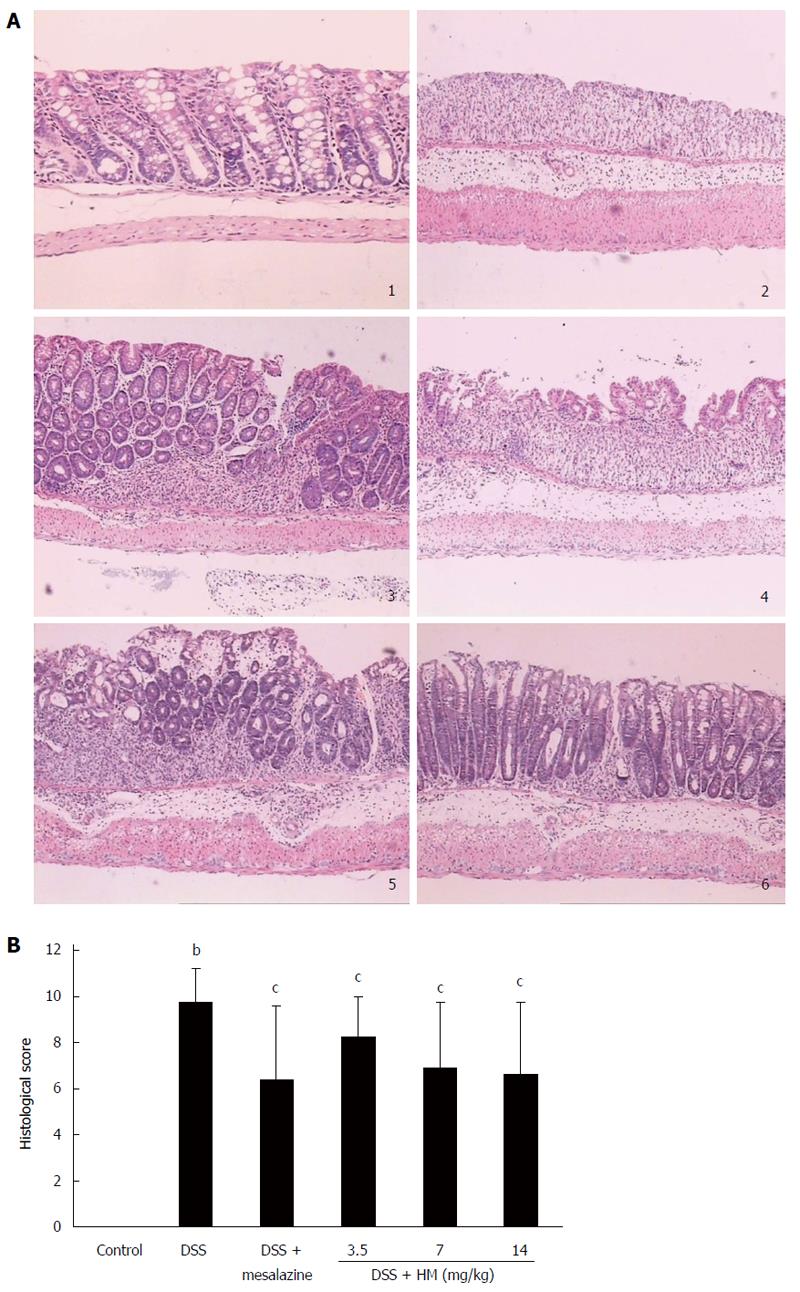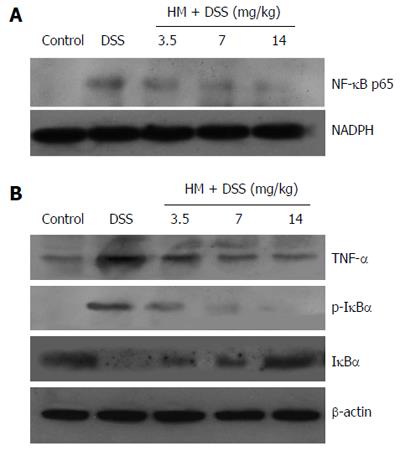Copyright
©2014 Baishideng Publishing Group Inc.
World J Gastroenterol. Nov 7, 2014; 20(41): 15310-15318
Published online Nov 7, 2014. doi: 10.3748/wjg.v20.i41.15310
Published online Nov 7, 2014. doi: 10.3748/wjg.v20.i41.15310
Figure 1 Effect of hydroxynaphthoquinone mixture on the clinical signs and body weight change of mice.
A: Body weight change; B: Disease activity index. Colitis was induced by administration with 3.5% dextran sulfate sodium (DSS) for 6 d. Hydroxynaphthoquinone mixture (HM) (3.5, 7, 14 mg/kg) or mesalazine 200 mg/kg was administered daily for 7 d. Disease progression was monitored daily by observation of clinical signs and body weight change. Data are presented as mean ± SD of eight to ten mice. aP < 0.05 vs control, bP < 0.01 vs DSS alone.
Figure 2 Effect of hydroxynaphthoquinone mixture on colon length (A), colonic myeloperoxidase activity (B) and serum tumor necrosis factor-α level (C) in dextran sulfate sodium-induced mouse ulcerative colitis.
Colitis was induced by administration with 3.5% dextran sulfate sodium (DSS) for 6 d. Hydroxynaphthoquinone mixture (HM) (3.5, 7, 14 mg/kg respectively) or mesalazine 200 mg/kg was administered daily for 7 d. Myeloperoxidase (MPO) activity was determined using an MPO detection kit. Tumor necrosis factor-α (TNF-α) level was determined by enzyme-linked immunosorbent assay. Data are presented as mean ± SD of eight to ten mice. bP < 0.01 vs control; cP < 0.05 vs DSS alone.
Figure 3 Effects of hydroxynaphthoquinone mixture on pathological injury.
A: Intestinal histopathological features; B: Pathological scores of colonic samples of each group. Colitis was induced by administration with 3.5% dextran sulfate sodium (DSS) for 6 d (original magnification, × 100). Hydroxynaphthoquinone mixture (HM) (3.5, 7, 14 mg/kg) or mesalazine 200 mg/kg was administered daily for 7 d. 1: Control; 2: Mice treated with DSS alone; 3: Mice treated with DSS plus mesalazine; 4-6: Mice treated with DSS plus HM (3.5, 7, 14 mg/kg respectively). Data are presented as mean ± SD (n = 8-10 mice). bP < 0.01 vs control; cP < 0.05 vs DSS alone.
Figure 4 Effects of hydroxynaphthoquinone mixture on the expression of tumor necrosis factor-α, nuclear factor-κB p65, inhibitor of nuclear factor-κB in dextran sulfate sodium-treated colon tissue.
A: The expression level of nuclear factor-κB (NF-κB) p65 in nuclear protein; B: The expression level of tumor necrosis factor-α (TNF-α), inhibitor of NF-κB (IκBα) and phosphorylation of IκBα (p-IκBα). Colitis was induced by administration with 3.5% dextran sulfate sodium (DSS) for 6 d. Hydroxynaphthoquinone mixture (HM) (3.5, 7, 14 mg/kg respectively) was administered daily for 7 d. Protein extracts were obtained from colons, and protein expression levels were detected by Western blot analysis.
- Citation: Zhang ZL, Fan HY, Yang MY, Zhang ZK, Liu K. Therapeutic effect of a hydroxynaphthoquinone fraction on dextran sulfate sodium-induced ulcerative colitis. World J Gastroenterol 2014; 20(41): 15310-15318
- URL: https://www.wjgnet.com/1007-9327/full/v20/i41/15310.htm
- DOI: https://dx.doi.org/10.3748/wjg.v20.i41.15310












